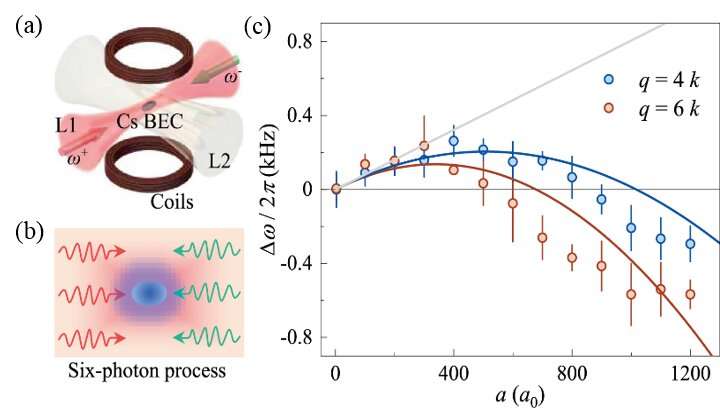Testing the universality of the Feynman-Tan relation in interacting Bose gases using high-order Bragg spectra
by Light Publishing Center, Changchun Institute of Optics, Fine Mechanics And Physics, CAS

The Feynman-Tan relation, obtained by combining Feynman energy relation with Tan’s two-body contact, explained excitation spectra of strongly interacting quantum gases of 39K atoms. However, whether Feynman-Tan relation is universal for other atomic species has remained out of reach. Now, this problem has been confirmed by Chinese scientists using high-momentum excitation spectra of interacting Bose gases of 133Cs atoms. This result provides significant insights for understanding the profound properties of interacting Bose gases.
Interactions play an important role in the most intriguing correlated quantum phenomena, and universal relations can greatly simplify the description of interaction effect in quantum many-body systems. In the elementary excitation spectra of interacting ultracold atomic gases, the Bogoliubov dispersion relation was given for explaining the linear response of excitation energy shift to the strength of interaction in weakly interacting regimes.
However, the breakdown of Bogoliubov theory was observed in the excitation spectra of strongly interacting Bose gases. Subsequently, the Feynman-Tan relation was proposed to explain the backbending behavior in excitation spectra of 39K Bose-Einstein condensate (BEC). Whether the Feynman-Tan relation is universal for describing strongly correlated behavior in other atomic systems has so far remained out of reach.
In this paper, a team led by Chinese Professor Suotang Jia in Shanxi University, have demonstrated the universality of Feynman-Tan relation in strongly interacting Bose gases of 133Cs atoms with large mass imbalance in comparison to the previously used 39K atoms. They studied the high-momentum excitation of 133Cs BEC with widely tunable interactions by using the second- and third-order Bragg spectra.
They observed the backbending of frequency shift of excitation resonance in the moderate interaction region, and the shift changes its sign from positive to negative at the strong interactions. Their results show good agreement with the predictions based on the Feynman-Tan relation, and this provides significant evidence for extending the application of the Feynman-Tan relation to different strongly interacting atomic systems.
The experiment starts with a BEC of 133Cs atoms in a cigar-shaped optical trap, where the atomic interaction can be widely tuned by a broad Feshbach resonance. A pair of counterpropagating laser beams are used to couple the zero-momenta atomic BEC to the high-momentum state for the two-photon Bragg spectra.
Specifically, they have developed four- and six-photon Bragg spectra to measure the high-momentum excitation spectra of BEC. They have measured the high-order Bragg spectra of 133Cs BEC under different interactions, and studied the variation of resonance frequency shift with the atomic scattering length. Their results show a significant deviation from the Bogoliubov dispersion theory, but are in good agreement with the predictions of the Feynman-Tan relation.
These scientists summarized the significant findings in their system: “Our experiment has demonstrated the universality of Feynman-Tan relation containing atomic mass for describing elementary excitation spectra of interacting Bose gases of 133Cs atoms with a large mass difference in compared to 39K atoms used in the previous study.”
“The high-momentum transfers involved in the second- and third-order Bragg spectra allow to observe the sign change of frequency shift in the excitation spectra at the relative low interactions. Our study provides significant insights for the understanding of collective excitation properties of strong interacting Bose gases.”
The work is published in the journal Light: Science & Applications.
More information:
Yunfei Wang et al, Testing universality of Feynman-Tan relation in interacting Bose gases using high-order Bragg spectra, Light: Science & Applications (2023). DOI: 10.1038/s41377-023-01103-8
Provided by
Light Publishing Center, Changchun Institute of Optics, Fine Mechanics And Physics, CAS
Citation:
Testing the universality of the Feynman-Tan relation in interacting Bose gases using high-order Bragg spectra (2023, March 2)
retrieved 2 March 2023
from https://phys.org/news/2023-03-universality-feynman-tan-interacting-bose-gases.html
This document is subject to copyright. Apart from any fair dealing for the purpose of private study or research, no
part may be reproduced without the written permission. The content is provided for information purposes only.
For all the latest Science News Click Here
For the latest news and updates, follow us on Google News.

